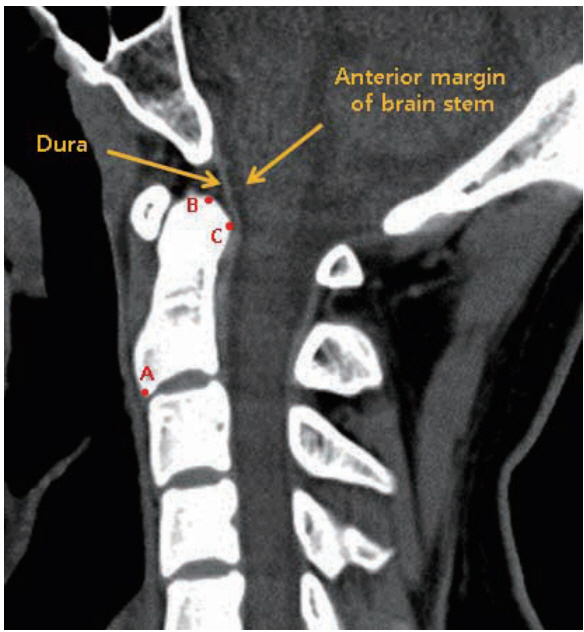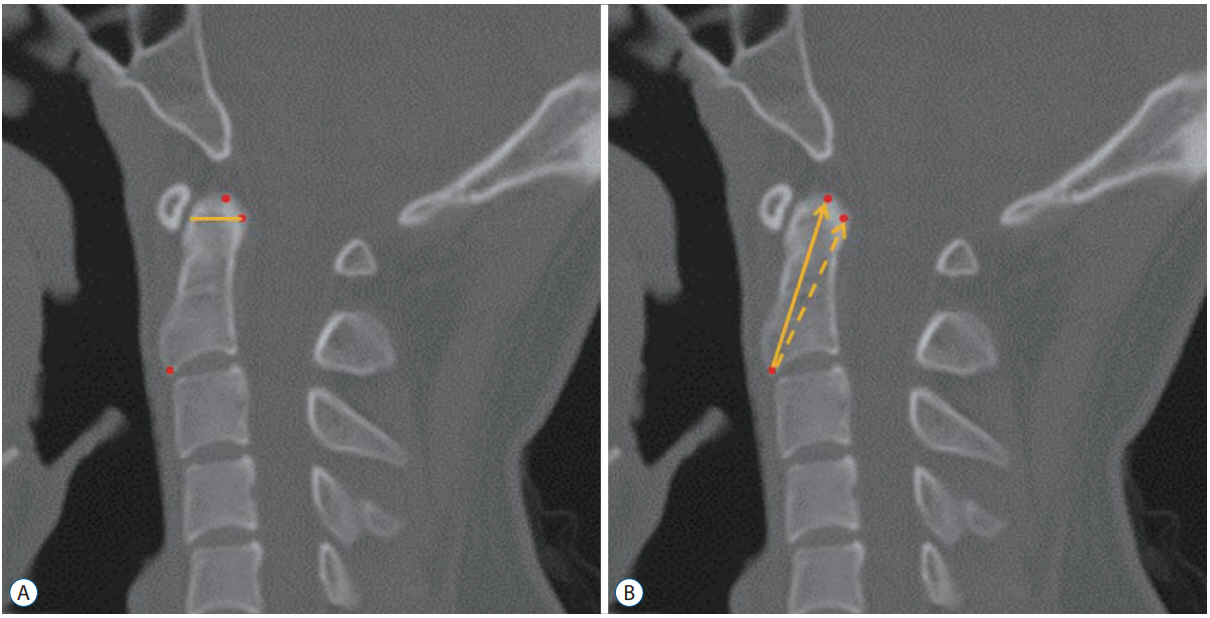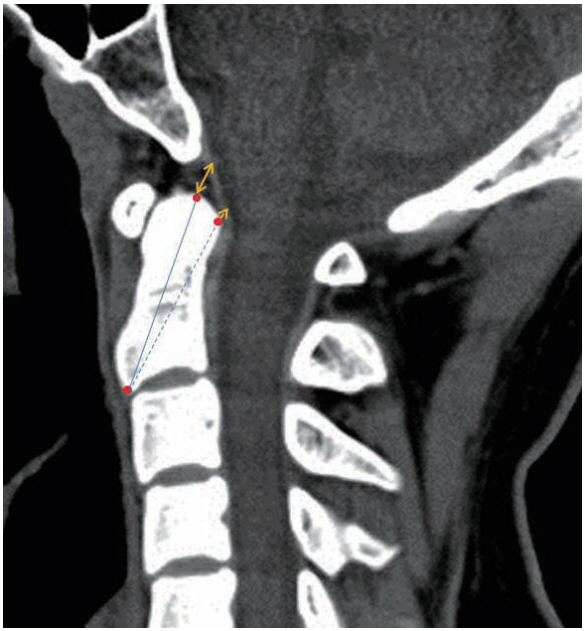J Korean Neurosurg Soc.
2018 Jul;61(4):503-508. 10.3340/jkns.2018.0034.
Safe Margin beyond Dens Tips to Ventral Dura in Anterior Odontoid Screw Fixation: Analysis of Three-Dimensional Computed Tomography Scan of Odontoid Process
- Affiliations
-
- 1Department of Neurosurgery, Kyungpook National University Hospital, Daegu, Korea. dccho@knu.ac.kr
- 2Department of Neurosurgery, School of Medicine, Kyungpook National University, Daegu, Korea.
- KMID: 2417327
- DOI: http://doi.org/10.3340/jkns.2018.0034
Abstract
OBJECTIVE
Anterior odontoid screw fixation is a safe and effective method for the treatment of odontoid fractures. The surgical technique is recommended for perforation of the apical cortex of the dens by the lag screw. However, overpenetration of the apical cortex may lead to potentially serious complications such as damages of adjacent vascular and neural structures. The purpose of this study was to assess the role of three-dimensional computed tomography (CT) scan to evaluate the safe margin beyond dens tip to ventral dura for anterior odontoid screw fixation.
METHODS
We retrospectively analyzed the three-dimensional CT scans of the cervical spines in 55 consecutive patients at our trauma center. The patients included 38 males and 17 females aged between 22 and 73 years (mean age±standard deviation, 45.8±14.2 years). Using sagittal images of 3-dimensional CT scan, the safe margins beyond dens tip to ventral dura as well as the appropriate screw length were measured.
RESULTS
The mean width of the apical dens tip was 9.6±1.1 mm. The mean lengths from the screw entry point to the apical dens tip and posterior end of dens tip were 39.2±2.6 mm and 36.6±2.4 mm. The safe margin beyond apical dens tip to ventral dura was 7.7±1.7 mm. However, the safe margin beyond the posterior end of dens tip to ventral dura was decreased to 2.1±3.2 mm, which was statistically significant (p < 0.01). There were no significant differences of safe margins beyond dens tip to ventral dura with patient gender and age.
CONCLUSION
Extension by several millimeters beyond the dens tip is safe, if the trajectory of anterior odontoid screw is targeted at the apical dens tip. However, if the trajectory of the screw is targeted to the posterior end of dens tip, extension beyond dens tip may lead to damage immediately adjacent to the vental dura mater.
Keyword
MeSH Terms
Figure
Cited by 1 articles
-
Current Concepts in the Treatment of Traumatic C2 Vertebral Fracture : A Literature Review
Subum Lee, Junseok W Hur, Younggyu Oh, Sungjae An, Gi-Yong Yun, Jae-Min Ahn
J Korean Neurosurg Soc. 2024;67(1):6-13. doi: 10.3340/jkns.2023.0098.
Reference
-
References
1. Andersson S, Rodrigues M, Olerud C. Odontoid fractures: high complication rate associated with anterior screw fixation in the elderly. Eur Spine J. 9:56–59. 2000.
Article2. Apfelbaum RI, Lonser RR, Veres R, Casey A. Direct anterior screw fixation for recent and remote odontoid fractures. J Neurosurg. 93(2 Suppl):227–236. 2000.
Article3. Assari S, Darvish K, Ilyas AM. Biomechanical analysis of second-generation headless compression screws. Injury. 43:1159–1165. 2012.
Article4. Börm W, Kast E, Richter HP, Mohr K. Anterior screw fixation in type II odontoid fractures: is there a difference in outcome between age groups? Neurosurgery. 52:1089–1092; discussion 1092-1094. 2003.
Article5. Chang KW, Liu YW, Cheng PG, Chang L, Suen KL, Chung WL, et al. One Herbert double-threaded compression screw fixation of displaced type II odontoid fractures. J Spinal Disord. 7:62–69. 1994.
Article6. Chi YL, Wang XY, Xu HZ, Lin Y, Huang QS, Mao FM, et al. Management of odontoid fractures with percutaneous anterior odontoid screw fixation. Eur Spine J. 16:1157–1164. 2007.
Article7. Cho DC, Sung JK. Analysis of risk factors associated with fusion failure after anterior odontoid screw fixation. Spine (Phila Pa 1976). 37:30–34. 2012.
Article8. Fountas KN, Kapsalaki EZ, Karampelas I, Feltes CH, Dimopoulos VG, Machinis TG, et al. Results of long-term follow-up in patients undergoing anterior screw fixation for type II and rostral type III odontoid fractures. Spine (Phila Pa 1976). 30:661–669. 2005.
Article9. Frangen TM, Zilkens C, Muhr G, Schinkel C. Odontoid fractures in the elderly: dorsal C1/C2 fusion is superior to halo-vest immobilization. J Trauma. 63:83–89. 2007.
Article10. Grauer JN, Shafi B, Hilibrand AS, Harrop JS, Kwon BK, Beiner JM, et al. Proposal of a modified, treatment-oriented classification of odontoid fractures. Spine J. 5:123–129. 2005.
Article11. Herbert TJ, Fisher WE. Management of the fractured scaphoid using a new bone screw. J Bone Joint Surg Br. 66:114–123. 1984.
Article12. Koivikko MP, Kiuru MJ, Koskinen SK, Myllynen P, Santavirta S, Kivisaari L. Factors associated with nonunion in conservatively-treated type-II fractures of the odontoid process. J Bone Joint Surg Br. 86:1146–1151. 2004.
Article13. Müller EJ, Wick M, Russe O, Muhr G. Management of odontoid fractures in the elderly. Eur Spine J. 8:360–365. 1999.
Article14. Park JW, Kim KT, Sung JK, Park SH, Seong KW, Cho DC. Biomechanical comparison of inter-fragmentary compression pressures: lag screw versus herbert screw for anterior odontoid screw fixation. J Korean Neurosurg Soc. 60:498–503. 2017.
Article15. Platzer P, Thalhammer G, Oberleitner G, Schuster R, Vécsei V, Gaebler C. Surgical treatment of dens fractures in elderly patients. J Bone Joint Surg Am. 89:1716–1722. 2007.
Article16. Platzer P, Thalhammer G, Ostermann R, Wieland T, Vécsei V, Gaebler C. Anterior screw fixation of odontoid fracture comparing younger and elderly patients. Spine (Phila Pa 1976). 32:1714–1720. 2007.
Article17. Tun K, Kaptanoglu E, Cemil B, Yorubulut M, Karahan ST, Tekdemir I. Anatomical study of axis for odontoid screw thickness, length, and angle. Eur Spine J. 18:271–275. 2009.
Article
- Full Text Links
- Actions
-
Cited
- CITED
-
- Close
- Share
- Similar articles
-
- Guidewire Breakage: An Unusual Complication of Anterior Odontoid Cannulated Screw Fixation
- Odontoid Process Fracture Treated by Anterior Odontoid Screw Fixation
- Anterior Screw Fixation of Anteriorly Displaced Type III Odontoid Fracture Corrected by Transoral Digital Manipulation
- Surgical Treatment of Odontoid Type II Fracture with Anterior Screw Fixation: Analysis of 15 Cases
- Strategies for Anterior Screw Fixation for Type II Odontoid Process Fracture, and Long-Term Follow-up Results




